



Ethanol Coproducts for Ruminant Livestock Diets
By Kenneth Kalscheur and Alvaro Garcia, Dairy Science Department, SDSU, Kurt Rosentrater, USDA - Agriculture Research Service and Cody Wright, Department of Animal and Range Science, SDSU.
Introduction
The rapid growth of the ethanol industry in the United States has generated large quantities of ethanol coproducts that are available as a feedstuff for livestock. These coproducts are often added to livestock diets as a source of protein and energy. The protein supplied can be degraded in the rumen to a variable extent, depending on the coproduct, while energy is provided by fat and fermentable fiber. Mineral concentrations in the coproducts can also be highly variable; to prevent excessive dietary mineral concentrations, this needs to be considered when formulating diets for livestock. As the ethanol industry continues to develop, new or altered feed coproducts will appear in the marketplace for use in livestock diets. There is a need to nutritionally define these products to determine their use in livestock diets.
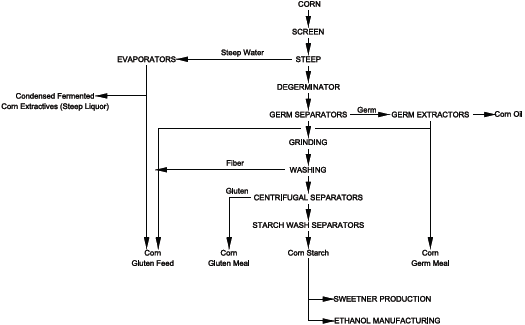
Figure 1. Flow chart for typical corn wet milling processing (based, in part, on Loy and Wright, 2003)
Ethanol production (wet milling and dry grind)
Two main techniques are used to produce ethanol: 1) wet milling and 2) dry grind processing. The corn wet milling process has been thoroughly reviewed by Johnson and May (2003). This process (fig. 1) consists of steeping the raw corn to moisten and soften the kernels, milling, and then separating the kernel components through processes including washing, screening, filtering, and centrifuging. Historically, the primary end products obtained from corn wet milling are industrial corn starch, which is utilized for sweeteners, corn oil, and ethanol (Johnson and May 2003). Additional end products from the wet milling process include several feed coproducts, including corn gluten feed (CGF), corn gluten meal (CGM), corn germ meal (CGM), and condensed fermented corn extractives (CFCE) (Loy and Wright 2003). The feed coproduct streams from corn wet milling account for approximately 30% of the raw corn input (typically 24% is converted into CGF while about 6% ends up as CGM); nearly 66% of the corn kernel is actually converted into starch; and 4% ends up as corn oil (Johnson and May 2003). These coproducts, however, are distinct entities compared to distillers grains, which are coproducts from dry grind processing.
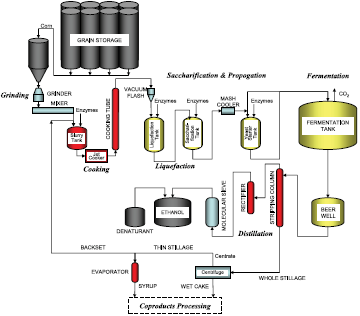
Figure 2. Flow chart for typical corn dry-grind fuel ethanol processing
Because of its lower investment and operational requirements, and because of advances in fermentation technology, dry grind processing (fig. 2) has become the primary method for ethanol production. In the traditional dry grind ethanol production process, the entire corn kernel is used during the fermentation process (Bothast and Schlicher 2005). Corn is screened and then hammer-milled to a medium-coarse to fine-grind meal. The resulting flour is combined with water to form a slurry, and enzymes are added to split the starch into glucose molecules. The resulting mash is then cooked and sterilized to kill non-desirable bacteria. Once cooled, yeasts are added to the mash and the glucose is converted to ethanol and carbon dioxide. Ethanol is then extracted in the distillation process and the remaining water and solids are collected and referred to as whole stillage (fig. 3). Whole stillage can be pressed, but it is more commonly centrifuged to separate the coarse solids from the liquid. The liquid is referred to as distillers solubles, or thin stillage. Thin stillage is frequently concentrated in an evaporator to become condensed distillers solubles (CDS), also referred to as syrup. The coarse solids, or wet cake, collected from the centrifuge are known as wet distillers grains (WDG). Wet distillers grains and CDS are combined to form wet distillers grains with solubles (WDGS) and can be dried to form DDGS. As a rule of thumb, each bushel of corn (56 lb.) will be converted into approximately 2.8 gallons of ethanol, 18 lb. of carbon dioxide, and 18 lb. of DGS. Put another way, each kernel of corn will result in about 1/3, 1/3, and 1/3 of the resulting products, respectively. Numerous companies are developing modifications to this dry grind process, and these innovations result in the development of new coproducts that can be used in livestock diets.
Wet milling coproducts
Processes in wet milling are considerably different than those in dry grind ethanol plants. This results in coproducts with differing nutrient profiles. The primary coproducts that result from wet milling include corn gluten feed (CGF), corn gluten meal (CGM), corn germ meal (CGM), and condensed fermented corn extractives (CFCE, also referred to as corn steep liquor) (Loy and Wright 2003). The nutrient composition of wet milling coproducts is presented in table 1.
Table 1. Nutrient composition (DM basis) of corn coproducts from the wet milling industry
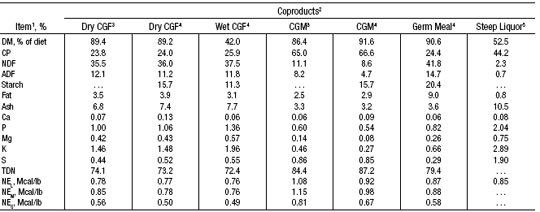
2Coproducts: CGF = corn gluten feed and CGM = corn gluten meal.
3NRC Nutrient Requirements of Dairy Cattle, 7th Rev. Ed. (2001).
4Analyzed by Dairy One Forage Lab from May 2000 to April 2008 (Number of samples of dry CGF - 230 to 803 depending on nutrient analyzed; Number of samples of wet CGF – 105 to 489; Number of
Corn gluten feed
Corn gluten feed (CGF) is comprised primarily of the portion of the kernel that remains after the starch, gluten, and germ have been removed. It is produced by combining the remaining corn bran with steep liquor and is commonly available as either dry or wet CGF. Nutrient composition can vary across different plants, depending on the amount and type of steep liquor added to the bran (Wickersham et al. 2004). For example, CGF is commonly reported as having approximately 24% crude protein (CP) (NRC 2001), although others have reported 16.5% CP (Wickersham et al. 2004). The protein in CGF is predominantly rumen-degradable protein (RDP) and is thought to contain a similar percentage of the crude protein as RDP as soybean meal. Corn gluten feed is recognized as a source of digestible fiber, making it a common ingredient in ruminant diets. This digestible neutral detergent fiber (NDF) is often used as a replacement for corn. One concern regarding the use of CGF in ruminant diets is the high concentration of phosphorus (often greater than 1%). Excretion of phosphorus will be increased if diets are formulated in excess of the animal’s phosphorus requirement.

Figure 3. Flow chart for typical dry-grind coproducts processing
Corn gluten meal
Corn gluten meal (CGM) is comprised primarily of the gluten protein stream separated from the starch after the removal of the germ and fiber. It is high in CP and low in fiber (table 1), making it a common ingredient in nonruminant livestock diets. If fed to ruminants, it is important to note that its CP is highly undegradable in the rumen. Mineral concentrations, especially sulfur, can be high in CGM.
Corn germ meal
Corn germ meal results from the solvent extraction of the oil from whole germ. It is often high in fiber with moderate levels of CP, fat, and starch (table 1). Corn germ meal is highly digestible and is a common ingredient in nonruminant diets. Of the minerals, phosphorus can be particularly high in corn germ meal because the phosphorus in corn is concentrated in the germ. It should be noted that new fractionation processes in dry grind ethanol plants are also producing a corn germ product. Nutrient composition of corn germ meal from wet milling and corn germ from dry grinding can be considerably different, therefore it is important to obtain a nutrient analysis of the feedstuff prior to its use.
Table 2. Nutrient composition (DM basis) of dried distillers grains with solubles (DDGS), from various references

2NRC Nutrient Requirements of Dairy Cattle, 6th Rev. Ed. (1989).
3NRC Nutrient Requirements of Dairy Cattle, 7th Rev. Ed. (2001).
4Sampled from 8 ethanol plants in Minnesota, South Dakota, and Nebraska.
5Sampled from 10 ethanol plants in Minnesota and South Dakota every 2 months for 3 years.
6Sampled from 4 ethanol plants in South Dakota and Minnesota for 3 consecutive months.
7Analyzed by Dairy One Forage Lab from May 2000 to April 2008 (Number of samples – 1,646 to 3,971 depending on nutrient analyzed).
Corn steep liquor
Corn steep liquor (also known as condensed fermented corn extractives) is the liquid fraction obtained from the corn steeping process. Corn steep liquor is a mixture of soluble protein, carbohydrates, vitamins, and minerals. The nitrogen fraction is high in free amino acids and small peptides. Of the minerals, steep liquor is very high in phosphorus, potassium, and sulfur.
Dry grind coproducts
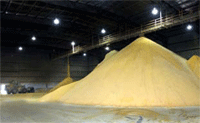
(photo courtesy of USDA-ARS)
Distillers grains with solubles (DGS) are the primary feed coproduct resulting from dry grind ethanol plants, and they can be produced as either dried (DDGS) or wet distillers grains with solubles (WDGS). It should be noted that AAFCO (2002) definition for DGS places the form (wet or dried) after the word “distillers” and before the word “grains.” For example, WDGS and DWGS are often used interchangeably in the feed industry. In addition, other cereal grains, such as sorghum, wheat, or barley, can be used to produce ethanol, although corn is the predominant grain used in the United States. In the AAFCO definition of DGS, the predominating grain is the first word in the name before DGS.
Knowing the accurate nutrient composition of ethanol coproducts is critical when formulating diets for livestock. Nutrient analyses of purchased ethanol coproducts are highly recommended but not always practical for every shipment. This information may also be provided by the ethanol plant. Tables 2, 3, and 4 show nutrient composition of ethanol coproducts from ethanol plants that are located mostly in the upper Midwest. The NRC values are book values published in the Nutrient Requirements of Dairy Cattle (1989, 2001). In addition, researchers at South Dakota State University (Holt and Pritchard 2004), University of Minnesota (Harty et al. 1998; Spiehs et al. 2002), and University of Wisconsin (Kaiser 2005) have analyzed DGS samples from numerous ethanol plants in Minnesota, Nebraska, South Dakota, and Wisconsin. Nutrient composition of ethanol coproducts is influenced by factors including the type and quality of the grain, the milling and fermentation processes, the drying temperature, and the amount of solubles added back to the wet coproducts before drying.
Table 3. Nutrient composition (DM basis) of wet distillers grains with solubles (WDGS), modified wet distillers grains with solubles (MWDG), and condensed distillers solubles (CDS) from various references
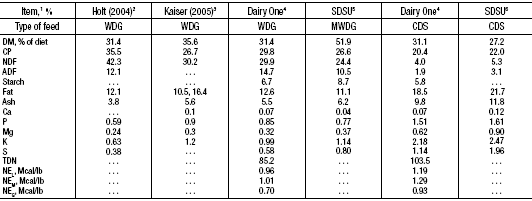
2Sampled from 3 ethanol plants in South Dakota and Minnesota for 3 consecutive months.
3Sampled from 3 ethanol plants in Wisconsin over a period of 9 months. Fat was measured in two different labs resulting in two different values.
4Analyzed by Dairy One Forage Lab from May 2000 to April 2008 (Number of samples of WDG - 571 to 1,532 depending on nutrient analyzed; Number of samples of CDS – 212 to 615 depending on nutrient analyzed).
5Modified WDG used in one experiment at South Dakota State University.
6Average of CDS used in 2 experiments at South Dakota State University.
Dried distillers grains with solubles
Dried distillers grains with solubles (DDGS) are obtained by combining the WDG with the CDS and then drying the mixture.
Ethanol coproducts have changed significantly since the 1980s (and before), when coproducts were derived primarily from the whiskey industry. Since the mid-1990s there has been significant growth in the fuel ethanol industry. The DDGS produced from these plants are sometimes referred to as “new generation” DDGS. Nutrient composition of these new DDGS has improved over the previous DDGS values. For example, DDGS produced from modern dry grind ethanol plants typically contain more protein and energy than previous reference values (NRC 1989). The newest dairy NRC (2001) lists crude protein (CP) at 29.7% for DDGS, a number close to commonly reported values (table 2). Average CP for DDGS is around 30%, but these studies illustrate that CP values ranging from 27 to 34% are not unusual. Distillers grains with solubles is also noted as a good source of rumen-undegraded protein (RUP). Most reported values range from 47% to 57% RUP; however, more recent research suggests the RUP may be higher. Research conducted at South Dakota State University determined the RUP of five different sources of DDGS ranged from 59.1 to 71.7% (Kleinschmit et al. 2007).
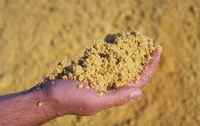
One concern for nutritionists is that the level of fat in all forms of DGS (dried or wet) can vary greatly, and can be higher than 12%, much higher than values reported in the NRC (2001). Distillers grains reflect the composition of corn oil with a high level of unsaturation, predominantly linoleic acid (C18:2). Lastly, DGS provides significant concentrations of minerals, which can pose challenges to nutrient management plans when fed above animal requirements. Most traditional DGS contain between 0.65 and 0.95% phosphorus; therefore, the animal’s requirement for this mineral is easily attained when DGS is included in the diet. The other mineral that can be highly variable is sulfur. High sulfur concentrations in feed and water can result in central nervous system disorders (known as polioencephalomalacia), which can lead to poor performance or death. Therefore, sulfur levels need to be monitored for total dietary intake.
Wet distillers grains with solubles
Wet distillers grains with solubles (WDGS) is sold for feed prior to drying. Traditional wet distillers grains contain 30 to 35% DM (table 3) and are similar in nutrient composition to DDGS. As demonstrated in table 3, the nutrient composition of WDGS can vary considerably — as shown by the differences reported in the studies of Holt and Pritchard (2004) and Kaiser (2005). These wet coproducts are often lower in price on a dry matter basis compared to DDGS, but the producer must determine if WDGS can be successfully used in his/her operation. There are benefits of using WDGS, particularly because of their high palatability and because of how they can condition diets that are particularly dry. Total mixed rations that contain 10 to 20% WDG on a DM basis maintain greater homogeneity as dry particles stick together. From a practical standpoint, this results in less particle separation and less sorting by livestock. Challenges producers have to face include 1) methods to conserve and 2) equipment to handle WDGS on the farm.
Modified wet distillers grains with solubles
Modified wet distillers grains with solubles (MWDG) are distillers grains that have either undergone partial drying or have been completely dried to DDGS and have had CDS added back to achieve a higher-moisture product. Dry matter of MWDG is typically between 45 and 55%. Nutrient composition is typically similar to those reported for WDGS and DDGS (table 3), but again they can vary depending on processing factors, especially the amount of solubles added back to the wet grains to make the final product. Nutrient composition of MWDG can vary significantly from plant to plant; therefore, nutrient analysis is highly recommended prior to use in specific diets.
Condensed distillers solubles
Condensed distillers solubles (CDS) is also sometimes referred to as “syrup.” It contains similar DM% to that of WDG (27 to 35%). Compared to other types of distillers grains, CDS are higher in fat (and consequently energy), lower in fermentable carbohydrates (such as fiber), but much higher in minerals (table 3). Minerals such as phosphorus, potassium, and sulfur are proportionally greater in CDS compared to the solids portion of the grains. Thus, as more CDS are added back to the grains, fat and minerals increase, but CP decreases in the final coproduct. This syrup can be sold separately, but most ethanol plants add it back in during WDG and/or DDGS processing. Condensed distillers solubles can also be dried to create dried distillers solubles.
Table 4. Nutrient composition (DM basis) of recently developed corn coproducts from the ethanol industry

2HP DDG = High protein dried distillers grains (Dakota Gold HP). Analysis is from www.dakotagold.com.
3Corn germ = corn germ dehydrated (Dakota Germ). Analysis is from www.dakotagold.com.
4Bran = bran of the corn grain (Dakota Bran). Analysis is from www.dakotagold.com and Janicek et al. (2007).
5Deoiled DDGS has the fat partially removed after fermentation (SDSU analysis).
Other ethanol coproducts
Until recently, most coproducts resulted from either traditional corn dry grind ethanol plants or from the corn wet milling industry. As new processes have been developed, new coproducts from these ethanol plants have resulted. In one such example, corn is milled into several fractions prior to fermentation so that the resulting products can be directed into different processing streams (Gibson and Karges 2006). This fractionation results in new end products such as high protein DDG (HP DDG), corn germ dehydrated, and corn bran. Furthermore, syrup can be added to the bran, resulting in a product being marketed as bran cake (Gibson and Karges 2006). Examples of these feeds are shown in table 4. These products are proprietary and therefore are specific to individual companies. As a result, the nutrient composition of these streams may vary significantly, depending on the company of origin.
Each of these fractions contains nutrients specific to the stream from which they originate. The bran is the seed coat of the corn kernel; therefore it will contain more fiber, but less protein. The germ is removed because it has low starch concentration but is rich in lipids and phosphorus. However, because the germ does not go through the fermentation process and is not combined with CDS, it contains substantially less sulfur than other products. The HP DDG results from fermenting the endosperm, where most of the starch is located. In this particular product, the CDS is not added back to the grains, making it a true DDG (with no solubles) (Gibson and Karges 2006).
Another new product on the horizon is a low-fat, or deoiled, DDGS (table 4), where the oil is partially removed from the DDGS post fermentation. Oil removed from the DDGS can be sold or further used in biodiesel production. Deoiled DDGS is lower in fat (it contains 2.5 to 3%) and proportionally higher in CP, fiber, and minerals than traditional DDGS.
Summary
Ethanol coproducts can be economical feedstuffs for ruminant diets. However, because their nutrient composition can vary considerably across the industry, it is critical to obtain nutrient analysis of these coproducts when formulating them into ruminant livestock diets. It is expected that, as new ethanol production processes are developed in the next few years, additional ethanol coproducts will be developed. These coproducts will likely be unique in nutritional composition and will require nutrient analysis to determine how they fit into livestock diets.
References
AAFCO. 2002. Official Publication. Association of American Feed Control Officials, Inc., Oxford, IN.
Bothast, R. J. and M. A. Schlicher. 2005. Biotechnological processes for conversion of corn into ethanol. Appl. Microbiol. Biotechnol. 67:19-25.
Dairy One Forage Lab. http://www.dairyone.com. Accessed May 2008.
DeFrain, J. M., J. E. Shirley, K. C. Behnke, E. C. Titgemeyer, and R. T. Ethington. 2003. Development and evaluation of a pelleted feedstuff containing condensed corn steep liquor and raw soybean hulls for dairy cattle diets. Anim. Feed Sci. Technol. 107:75-86.
Gibson, M. L. and K. Karges. 2006. By-products from non-food agriculture: Technicalities of nutrition and quality. Pages 209- 227 in Recent Advances in Animal Nutrition. Nottingham University Press, Nottingham, UK.
Harty, S. R., J-M. Akayezu, J. G. Linn, and J. M. Cassady. 1998. Nutrient composition of distillers grains with added solubles. J. Dairy Sci. 81:1201. (Abstr)
Holt, S. M. and R. H. Pritchard. 2004. Composition and nutritive value of corn co-products from dry milling ethanol plants. South Dakota Beef Report, BEEF 2004-01, pp. 1-7. http:// ars.sdstate.edu/extbeef/2004/BEEF_2004-01_Pritchard.pdf. Accessed Feb. 2008.
Janicek, B. N., P. J. Kononoff, A. M. Gehman, K. Karges, and M. L. Gibson. 2007. Short Communication: Effect of increasing levels of corn bran on milk yield and composition. J. Dairy Sci. 90:4313-4316.
Johnson, L. A. and J. B. May. 2003. Wet milling: the basis for corn biorefineries. Pages 449-494 in Corn Chemistry and Technology. P. J. White and L. A. Johnson (eds). American Association of Cereal Chemists, Inc. St. Paul, MN.
Kaiser, R. M. 2005. Variation in composition of distillers wet grains with solubles. Proceedings of the 4-State Dairy Nutrition & Management Conference, Dubuque, IA, pp. 191-197.
Kleinschmit, D. H., J. L. Anderson, D. J. Schingoethe, K. F. Kalscheur, and A. R. Hippen. 2007. Ruminal and intestinal degradability of distillers grains plus solubles varies by source. J. Dairy Sci. 90:2909–2918.
Loy, D. D. and K. N. Wright. 2003. Nutritional properties and feeding value of corn and its by-products. Pages 571-603 in Corn Chemistry and Technology. P. J. White and L. A. Johnson (eds). American Association of Cereal Chemists, Inc. St. Paul, MN.
National Research Council (NRC). 1989. Nutrient Requirements of Dairy cattle. 6th rev. ed. Natl. Acad. Sci., Washington, DC.
National Research Council (NRC). 2001. Nutrient Requirements of Dairy cattle. 7th rev. ed. Natl. Acad. Sci., Washington, DC.
Spiehs, M. J., M. H. Whitney, and G. C. Shurson. 2002. Nutrient database for distillers dried grains with solubles produced from new ethanol plants in Minnesota and South Dakota. J. Anim. Sci. 10:2639-2645.
Wickersham, E. E., J. E. Shirley, E. C. Titgemeyer, M. J. Brouk, J. M. DeFrain, A. F. Park, D. E. Johnson, and R. T. Ethington. 2004. Response of lactating dairy cows to diets containing wet corn gluten feed or a raw soybean hull-corn steep liquor pellet. J. Dairy Sci. 87:3899–3911.
August 2008


